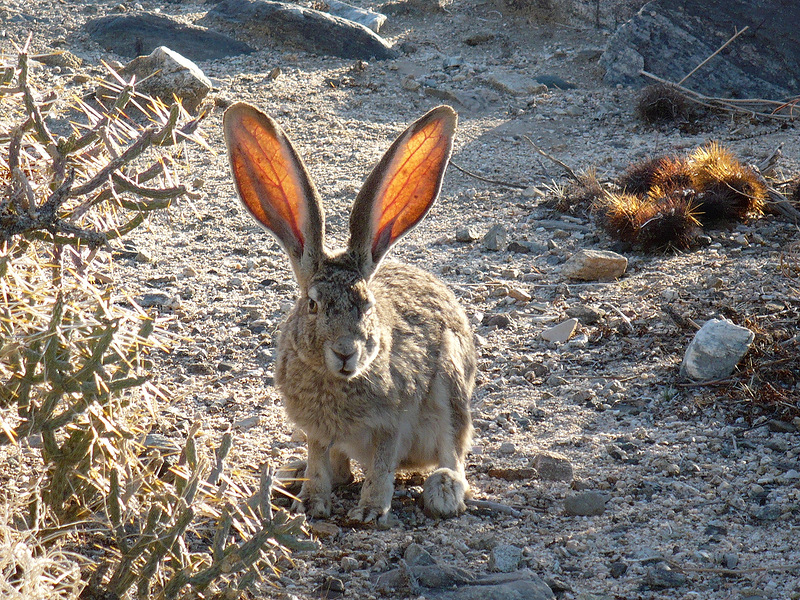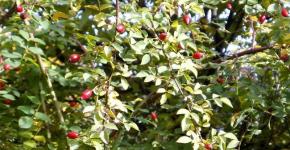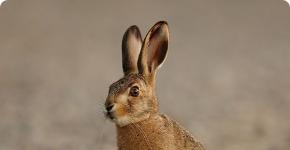The list of types of names of hares which hares are. These amazing hares and rabbits
Hare-hare (Latin Lepus europaeus) - one of the most common representatives of the hares family. It is found in the steppes of Europe, Asia and North Africa. In addition, at the end of the nineteenth century, it was introduced to North America, where it settled down well in the Great Lakes region. The hare was also able to acclimatize in New Zealand and southern Australia, where it quickly became a pest, competing with local unique animals and destroying rare plant species.
As for our country, the European hare is well known from ancient times. How many fairy tales and fables are folded in his honor, it is difficult to imagine! There are among them both a “little gray hare”, and a brave hare, and a sly one…. By the way, the tricks of the hare and the hare really do not hold: he so skillfully confuses the tracks, lying down on a bed or fleeing a chase, which confuses even experienced hunters.

Rusak prefers open spaces: steppes, forest-steppe zones, logging, fields and meadows. He especially likes the localities where wide areas alternate with small plantations, beams and ravines. Sometimes found in forests, but chooses not too dense thickets. The fact is that in the open, it is easier for him to escape from prosecution, because this animal can reach speeds of up to 50-60 km / h.
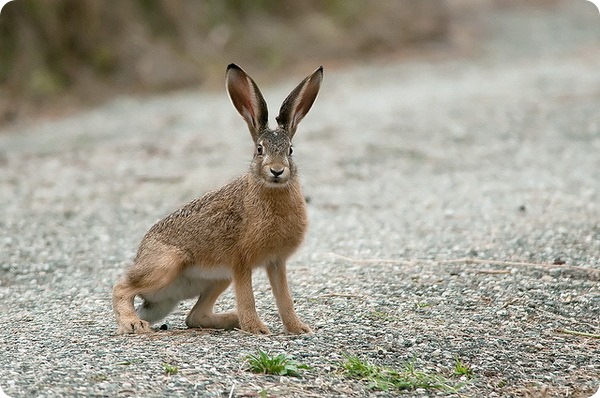
The hare is not a small animal: it weighs from 4 to 6 kg with a body length of 55-68 cm. It is very easy to distinguish it from the hair on longer ears (from 9 to 14 cm), long tail (7-14 cm ) and, of course, a darker color, because the hare even in winter is never completely white. Interestingly, its paws are slightly shorter and narrower than those of the hare, since in the localities where the hare lives, the snow is relatively shallow and not so loose.

This bunny feeds on plant food: grass, seeds, young shoots and leaves. In winter, it can devour the bark of trees, while the bark of apple and pear trees is considered especially tasty, which is not very good for summer residents. Also the hare will never give up vegetables and melons, and will gladly eat the remains of garden crops, having dug them out from under the snow.
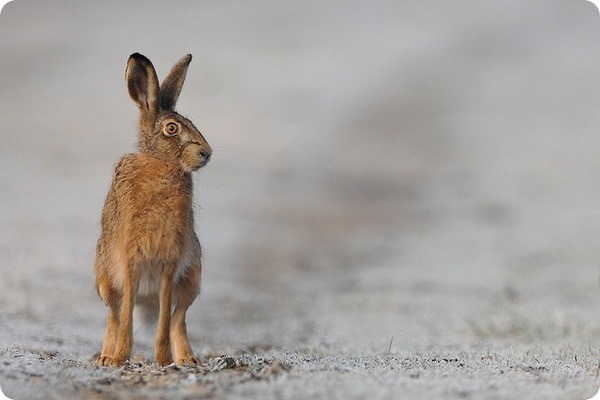
These shy and cautious animals are active in the dark. They get out of the shelters at dusk and till the morning they search for something more delicious. During the day, they rest under bushes, in their own dug burrows or in the abandoned dwellings of badgers, woodchucks and even their worst enemies - foxes. At the same time in winter their burrows are much deeper and warmer than in summer.

The hare lives in proud loneliness, only in the breeding season you can meet several animals at once. For one season in warm areas, the hare manages to bring up to 5 broods, 1-5 babies each. There are only two broods in the northern areas, but the number of hares in them increases to nine.
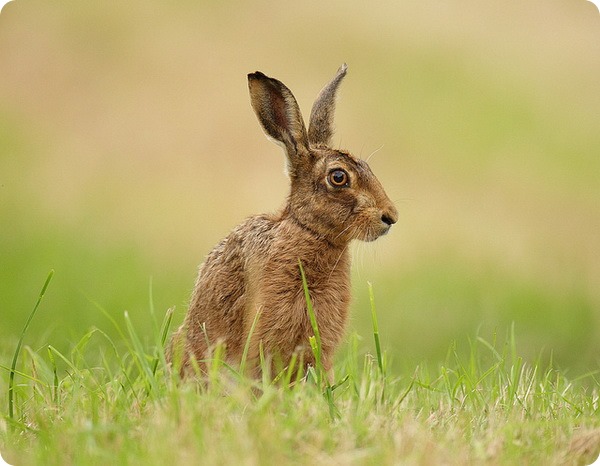
How does she do it? It's very simple: pregnancy lasts only 1.5 months and immediately after the birth (and even before them), the hare mates again. Hares feed exclusively on mother's milk for only 2 weeks, gradually switching to solid food. At the age of 3-4 weeks, they are already separated from the mother, giving her the opportunity to take up new offspring.
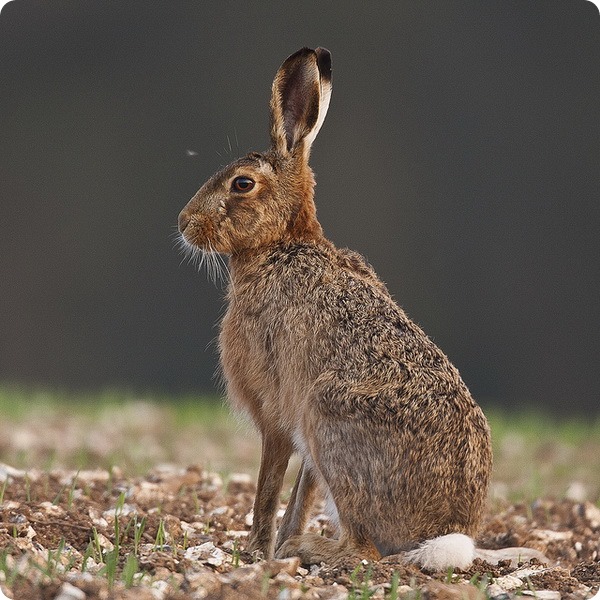
The life span of most animals is from 4 to 5 years, although in captivity some of them successfully celebrate their twelfth birthday.
A white hare and a brown hare are widely distributed in central Russia. In the summer, both representatives of the hare-type squad have wool. In winter, the hare becomes much lighter, and the white hare is painted in pure white (hence the nickname of the beast). Where they live lives in the forest. This is a forest hare. Rusak can live in the fields and steppes. So the question of where the hares live, the answer is not quite straightforward.
Belyak: daily routine and meals
During the day, the hare usually sleeps where it lives. The hare in the forest only comes out at night to feed. In winter, it feeds mainly on the bark of various trees. The white hare does this in a very original way, rising on its hind legs to reach the cortex more gently, as if standing at attention. The hare gnaws off the branches of young aspen buds, birch trees, willow bark, willows and other deciduous trees. Loves young fruit plants.
In winter, the white hare can move quite easily through deep snow, since its legs (even between the toes) grow wool. And warm, and stay in the snow is much easier. The leg becomes wider, and the hare runs, as if on skis. By the way, when the hare jumps, he puts his hind legs forward like a squirrel, leaving characteristic traces in the snow.
In shelter
The bed is the so-called winter (and summer) den, where the hare lives in the forest from time to time. You can get to the secret place in the wake of a white hare. But, most likely, it will be very difficult to do this. Before you lie down, the hare strenuously confuses the tracks, dodges and jumps from side to side (it makes sweeps). And only finally having confused everyone, the animal finally falls into an oblong hole. In her, the hare hides from all sorts of enemies, and he has enough of them: wolves, foxes, owls, eagles, dogs, lynxes. Also - hunters and poachers of all ranks and stripes.

In the bed you can hide from the piercing autumn and winter wind. In a strong winter blizzard a white hare can bring snow, as they say, "to the ears." Above it forms a set of snow and ice. Then the hidden hare, going out into the light, has to be dug out of the caches. So the question of where the hares live can be answered like this: some of the time is lying. There they hide from enemies and the wind.
Where do hares live?
These are field and steppe animals (for the most part), unlike white hares, who mostly live in the forest. Hares almost always sleep during the day and feed at night. They dig snow over winter and eat green shoots. If the hare cannot for any reason (deep snow, ice, frost) get to winter crops, he will resort to vegetable gardens, where he eats the remaining stalks or untied carrots. It is also selected for eating dry grass. Willingly regales in gardens and bark of fruit trees - young apple trees. Rusaki thus cause great harm to the national economy - the fields, gardens and orchards. For this they dislike the villagers.
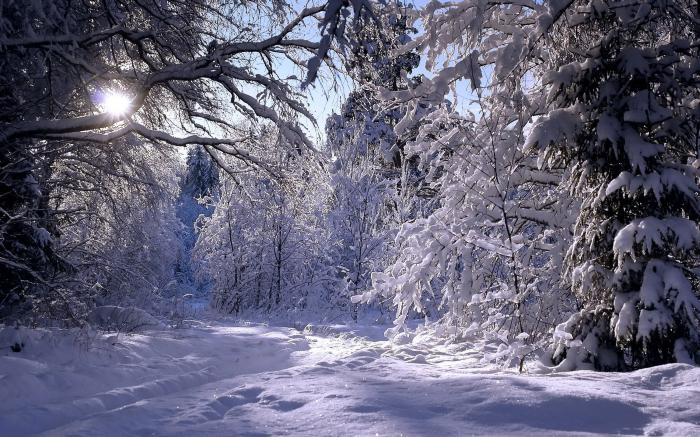
Where do hares live in winter and summer?
These animals live alone or in pairs. Unlike their rabbit brothers, hares almost never dig holes. They build their nesting sites in small, ready-made pits. The hare tribe is known for its fertility: a hare makes 3-4 litters per year (from March to September), each with 5-10 cubs. They are born with already open eyes and hair, quite independent, but some die from enemies in the first months of their lives. The fact is that the mother, after feeding, runs away from the babies in two or three days. All this time they are sitting, crouching in the grass. A few days later, the hare again resorts to feed them. Interestingly, this can be done by another female who has found a rabbit.
What helps a hare?
Fleeing from enemies, which the hare has plenty of, the animal can run up to 70 kilometers per day, making wide circles and winding through a forest or field. These traces are sometimes difficult for a skilled hunter to unravel. So the hare is saved by its main defense - the ability to run fast. And the white hare in the winter and the corresponding color of the skin come in handy. Rusak, fleeing from the chase, sometimes can stop, as if listening and trying to see the enemy. But the hare is well developed only hearing, and sight and smell - not very. So, a white man can get close enough to a man standing still, which is what experienced hunters use.
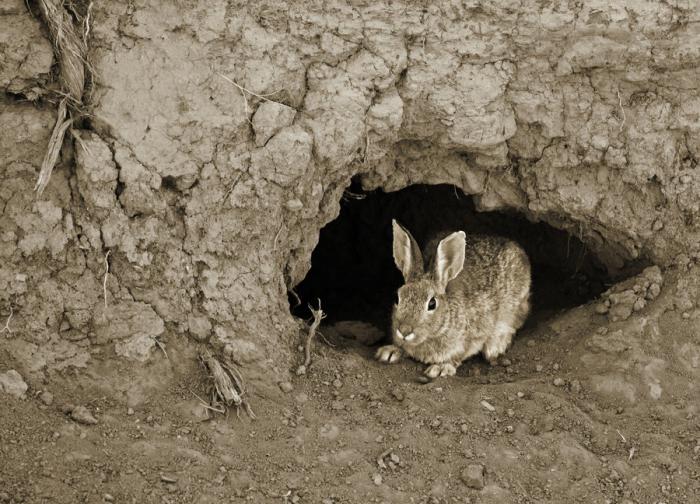
Bed or hole?
The bed, especially if the hare is not particularly disturbed, can be used many times as a place for temporary shelter. But most often the hare is looking for new places. But in the winter, he digs holes in the snow up to one and a half meters deep, in which he spends most of his time, going outside only in search of food or in case of danger.
Interestingly, the white hair only compresses the snow, without throwing it out. Hares living in the tundra, in the winter, dig burrows up to eight meters long, using them as permanent shelters. In the event of a danger, the whites of the tundra do not leave the burrow, but hide inside and wait. And in the summertime, empty ground moves of marmots and arctic foxes are used as shelters. Where do hares live? In the holes left by other animals. It is spacious and has enough space for long-eared.
Brown hare Refers to large hares: body length 57-68 cm; weight 4-6 kg, rarely up to 7 kg. The largest individuals are found in the north and northeast of the range. The build is fragile. Externally, the hare is well distinguished from the hare by its longer ears (9.4-14 cm), a long wedge-shaped tail (7.2-14 cm long), black or black-brown in color from above. The eyes are reddish brown. The hind limbs are longer than those of the hare, but the paws are shorter and narrower (foot length is 13.6-18.5 cm), because the hare lives in regions where the snow cover is relatively shallow and hard. Summer coloring is ocher-gray, brown, brown, ocher-red or olive-brown, of different shades. Characterized by large dark mottled, formed by the ends of the hair undercoat. The ends of the guard hairs are buff. The hare's coat is shiny, silky, noticeably curled. The sides are painted lighter than the back; belly white, without ripples. There are white rings around the eyes. The tips of the ears are black all year round. Winter fur is a little lighter than summer fur (unlike white hares, hares never become snow-white in winter); the head, the tips of the ears and the front of the back remain dark in winter. Sexual dimorphism in color is absent. In the karyotype of 48 chromosomes.
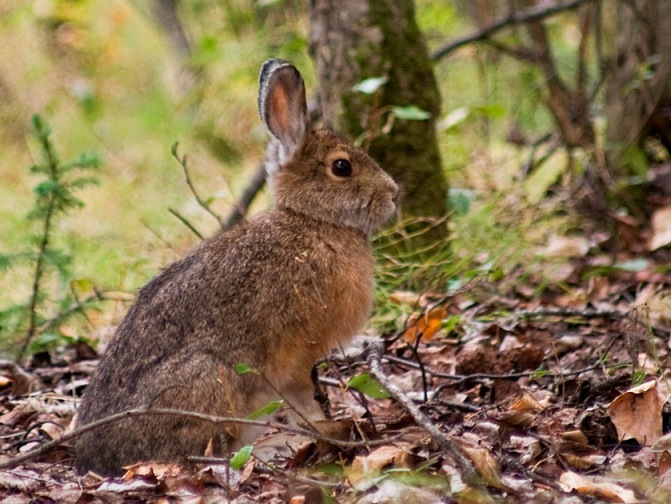
Like all hares, the hare of the hares passes in spring and autumn. Spring moult usually begins in the second half of March and lasts 75-80 days, ending by mid-May. It proceeds most violently in April, when the wool falls out in shreds. The general direction of the molt is from the head to the back of the body. In the autumn, summer hair gradually falls out, and they are replaced by a thick and lush winter fur. The direction of the autumn molt back to the direction of spring - it begins with the hips, then moves to the croup, ridge, front paws and sides. Summer fur lasts the longest on the back and near the eyes. Shedding usually begins in September; it ends at the end of November, although in warm weather it can take until December.
SpreadRusak is the primordial steppe animal of Europe, Western and Minor Asia and North Africa. Its resettlement to the north probably began not earlier than the middle of the Quaternary. It is currently distributed in steppes, forest-steppes, tundra and sparsely forested areas of the forest zone of Europe, in the north to Ireland, Scotland, southern Sweden and Finland, in the south to Turkey, Transcaucasia, Iran, northern Arabian Peninsula, North Africa, northern Kazakhstan. Fossils are known from the Pleistocene deposits of Azerbaijan and the Crimea. Within Russia, it is found throughout the European part of the country to the northern coasts of the Ladoga and Onega lakes, and the Northern Dvina; further, the distribution boundary goes through Kirov, Perm, skirting the Ural Mountains, through Kurgan to the Pavlodar region of Kazakhstan. The southern border passes through the Caucasus, the Caspian Sea, Ustyurt, northern Aral to Karaganda. Acclimatized in a number of regions of Southern Siberia (foothill areas of Altai, Salair and Kuznetsk Alatau). It was produced in the Altai and Krasnoyarsk Territories, in the Novosibirsk, Kemerovo, Irkutsk and Chita regions. Acclimatized in the Far East: in the Khabarovsk Territory released in 1963-1964. (Jewish Autonomous Region), in 1965 - in the Primorsky Territory (Ussuriysky and Mikhailovsky Districts). In Buryatia, attempts to acclimatize were unsuccessful. Artificially settled in North America. So, the hare was introduced to the state of New York in 1893 and in 1912 to the province of Ontario (Canada). Now found mainly in the Great Lakes region. Delivered to Central and South America; was acclimatized in New Zealand and southern Australia, where it turned into a pest.
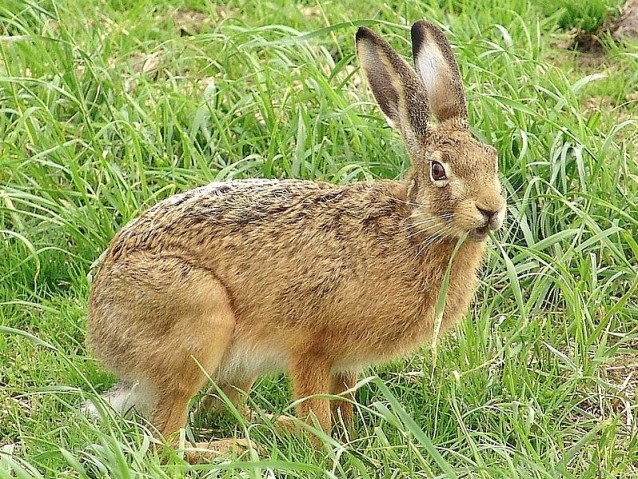
The inhabitant of open spaces, forest-steppe, steppe, desert-steppe landscapes. Its main habitats in the forest zone are open places: fields, meadows, forest edges, extensive clearings, glades, and soot. In the depths of coniferous forests is rare, more common in deciduous forests, although here it prefers light forest. The hare is especially loved by the land, where agricultural land alternates with small woods, bushes and a network of ravines and gullies. In the forest-steppe and steppe zones found on the beams, floodplains of rivers, on deposits and crops of grain crops. It is found in the mountains up to the alpine belt, inhabiting not only mountain steppes, but also forests. In summer it rises in the mountains up to 1500-2000 m, in winter it goes down. Everywhere, to the settlements (especially in winter), as well as to water bodies. Normally, hare is a settled territorial beast. Depending on the forage habitat, it can constantly keep on one site occupying 30-50 hectares. In other areas, hares make daily migrations from the places of their beds to the places of feeding, walking ten kilometers. Seasonal movements also occur; In the fall and winter, the hare often moves closer to settlements, forest margins and to elevated areas where there is less snow. In the mountains, in the fall they descend into the floodplains of the rivers, and in the spring they rise back to the mountains. Under adverse conditions (high snow cover, ice crust) that interfere with getting forage from under the snow, there is a massive displacement. In the southern areas, the movements of hare are noted in the spring-summer period and are associated with human economic activity. Rusacs are active mainly in twilight and night hours. Only during the rut period, daily activity is observed everywhere. The greatest activity occurs in the first half of the night and in the early morning hours. For one fat hare runs up to several kilometers; animals living in open areas usually pass more than those inhabiting forest edges and shrubs. Under adverse conditions the hare may not go out for a few days. A hare in the summertime is usually just a small hole dug under the cover of a bush, a fallen tree or a clump of tall grass. Often just lies under a bush or in a field border. Permanent holes do not suit, sometimes digs temporary daytime holes with extreme heat. It can rest in the abandoned burrows of badgers, foxes and marmots. The location of the Ruska shelters depends on the season and weather conditions. In spring, the beds are often located in heated places; in rainy weather, the hare keeps on dry elevations, and in dry, on the contrary, in lowlands. In winter, the bed is arranged in the snow in a place closed to the wind; in areas with deep snow, hare hacks sometimes dig holes up to 2 m in length. Often hare lay in autumn and winter in haystacks, near buildings on the outskirts of settlements. A hare runs faster than a white hare; his jumps are longer. At a short distance, it is able to reach a running speed of up to 50-60 km / h in a straight line. Confuses the tracks. Can swim well. Like all hares, hares are silent animals; only when they are caught or wounded do they emit a high piercing cry. The female calls for a hare, making quiet sounds. A disturbed hare cracks his teeth, like many rodents do. Another type of communication is pounding like pounding a drum.
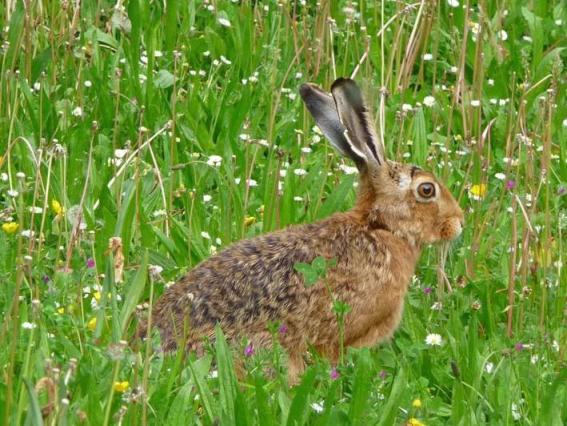
In summer, the hare feeds on plants and young shoots of trees and shrubs. Most often eats leaves and stems, but can dig up and roots; in the second half of summer, it eats seeds (contributes to their distribution, since not all seeds are digested). The composition of the summer ration feed is very diverse - various wild-growing (dandelion, chicory, tansy, bird mountaineer, colza, clover, alfalfa) and cultivated (sunflower, buckwheat, cereals) plants. Willingly eats vegetables and melons. In winter, unlike the white hare, it continues to feed on seeds and rags of grasses, winter crops, remnants of garden crops, digging them out from under the snow. With a deep snow cover, it switches to feeding on woody and shrub vegetation (shoots, bark). Most eagerly eats maple, oak, hazel, broom, as well as apples and pears; aspen and willow, favored by the hare, consumes less frequently. Bunny winter pigs love to visit the gray partridges, who are not able to dig up the snow themselves.
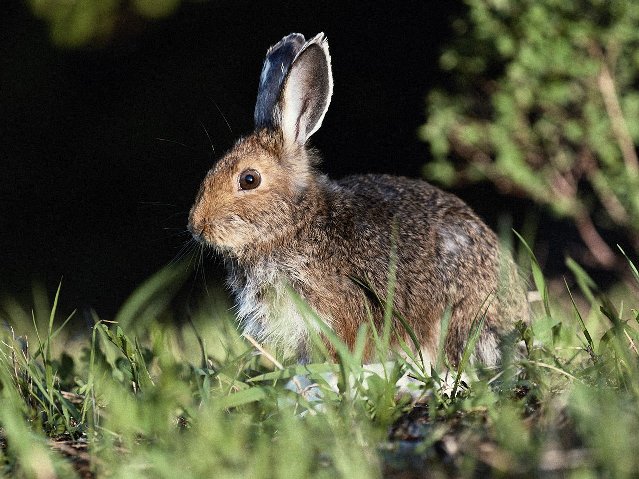
The duration and timing of the breeding season of hares differ depending on the part of the range. So, in Western Europe it usually lasts from March to September; During this time, about 75% of females have time to bring 4 broods each, and in the years with warm winter and early spring - and by 5. In favorable climatic conditions the rut lasts all year, and the first rabbits appear already in January. In the north of the range of broods 1-2. In central Russia, the first rut takes place at the end of February - March (males are active from January), the second - in April - early May, the third - in June. Pregnancy lasts 45-48 days, so the first rabbits appear in April - early May, the second brood - at the end of May - June (reproduction peak), the third - in August. Re-hares mate immediately after childbirth, and sometimes before. In general, the rut of the Rusakov does not go together as well as that of the hares, so that pregnant females and hares can be found earlier and later than normal seasons. The number of hares in a brood ranges from 1 to 9. Many conditions affect the brood size. In general, broods are larger in areas where hares have fewer reproductive cycles. Winter, early spring and autumn broods are less summer, in them 1-2 hare. Middle-aged females bring the most hares. Before giving birth, females make primitive nests of grass, dig holes, or, in hot climates, shallow burrows. The hares are born sighted and covered with fur, weighing 80-150 g. The female comes to feed the offspring once a day, and sometimes less often - up to 1 time in 4 days. From the fifth day of life, the hares begin to move near the place of birth; by 2 weeks they reach a weight of 300-400 g and are already actively eating grass, and in 3-4 weeks they become independent. There are known cases of feeding hares of foreign hares, provided that they are of the same age as her own, but this is observed less often than in a white hare. The hares usually reach sexual maturity only the following spring; very rarely, in the western parts of the range, females start breeding on the same summer. Known hybrids hare with hams (cuffs). They were found both in nature and obtained when keeping hares in the zoo. When kept in captivity, cuffs are able to multiply. The life span of hares is 6–7 years (in exceptional cases they lived to be 10–12 years old), but most animals live no more than 4–5 years.

In general, the brown hare is the most common species, whose numbers in some years reach many millions of individuals. The number is experiencing significant changes over the years depending on various factors: epizootic, fodder, etc., but they are not as sharp as those of the hare. In the taiga, the cycle of oscillations is 10-11 years; in the south of the range, oscillations are more frequent and more disorderly. Rusak is a valuable commercial animal, an object of amateur and sport hunting. It is produced annually in significant quantities for the sake of meat and skins. It can harm winter crops, orchards and nurseries: a hare can gnaw 10-15 fruit trees overnight. In Argentina, Australia and, to a lesser extent, in North America, introduced rusaks are pests of agriculture. Rusaki suffer a number of diseases. Although, unlike whites, they are less susceptible to diseases of pulmonary worm disease and less likely to become infected with hepatic trematodes, coccidiosis is widespread among them, especially among young. Mass mortality from this disease occurs between the ages of 5 weeks and 5 months. Epizootics of pasteurellosis, tularemia, porcine brucellosis and other infectious diseases are known; is a carrier of toxoplasmosis. Rusaks are more likely than whites to suffer from adverse weather conditions. Multi-snow wintered winters are especially destructive for them, which do not allow hares to feed normally, and unstable spring with alternating thaws and frosts, during which early broods perish. Predators play a certain role in changes in their numbers. Foxes, wolves, coyotes, lynxes, eagles hunt hares.
White hare. The mammal hare-hare is one of the representatives of the hare family, which is included in the hare-like squad.
Appearance of hare
Among hares, the white hare is a rather large animal with a length of 44 cm — 65 cm and a weight of 2.5 kg — 4.5 kg. Sometimes the length of his body can be up to 75 cm, and weight up to 6 kg. The dimensions are directly related to the habitat. White hares are the largest in the north of Western Siberia, much smaller in Yakutia, and the smallest in the south of the Far East and Transbaikalia. The middle lane is a medium hare habitat of medium size with a weight of 3-4 kg. The ears are not too long (up to 10 cm in total) and are slightly bent forward. The tail is rather short (5–10 cm), its shape is rounded. Front legs shorter than rear. The paws are rather wide and in winter they are thickly covered with elastic hairs, the fingers are also strongly pubescent and can spread wide. This increases the area of \u200b\u200bsupport legs and does not allow the hare to fall into the snow. The color of white hare fur changes twice a year: in winter it is white, and in summer it is mostly reddish brown or reddish gray depending on the habitat. The tips of the ears are constantly black. The fur on the head is darker than on the back, on the sides even lighter, and on the belly is white. The color of fur in the winter can not change if the hares live in places where the snow does not stay long, or remain white all year round where the snow practically does not melt. Males of whites, on average, are slightly smaller than females.
White hare molt
Twice a year - in the spring and autumn a molt occurs at the hare, the period of flow of which is determined by the air temperature. Spring moult runs approximately from March to May and is most intense during snow melting. At the same time it starts from the head and goes to the rump, and from the back it goes to the belly. In autumn, the molt goes from the end of August to mid-November in the reverse order: first the hind legs, then the front and sides. The back and head molt at the end of a period that ends with the establishment of snow cover. Adult animals molt faster than young ones.
White hare spread
The distribution of the hare is very extensive. It lives in Northern Europe (forest and tundra zones), almost everywhere in Russia (it does not exist only in the southern part of the steppe zone, as well as in Ciscaucasia and the Caucasus), in Kazakhstan, and partly in Mongolia (north-west), China ( northeast) and Japan (Hokkaido Island). It is found in Chile and in Argentina. To the north, its range extends to the Arctic Ocean. Caught on separate Arctic islands, is also found in the Alps.
White hare habitats
Within the limits of distribution, hares are unevenly settled, occupying a wide variety of lands, where they can find reliable protection and sufficient food. There is also a seasonal density of their distribution, which is the most uniform in summer. In the tundra zone, river valleys and shores of large lakes with an abundance of shrubs are preferred. Sea coast - for them, too, familiar. In the forest zone, sparse areas with meadows, river valleys and creeks, areas of overgrown cuts, where there are good protective conditions and a lot of food, are more often chosen. The most favorable conditions for whitefish are found in the central regions of Russia, where small coniferous and deciduous forests alternate, large areas of shrubs and farmland. In the south of Western Siberia, in the Kazakhstan forest-steppe, they are usually settled along small birch woods. In Eastern Siberia, river valleys, overgrown with willow trees, and deciduous forests, where undergrowth is well developed, are chosen. In the mountains, hares are found both in the foothills and in the mountain tundra. Often caught close to the settlements.
White hare lifestyle
The norm for a white hare is a single territorial way of life. Everyone has their own site, which he knows well. Mostly it is a sedentary animal. Seasonal movements occur in the spring, when animals move to more open places, where the first grass appears earlier, and in the fall to the forest, where it is better to hide in the developed underbrush. Abundant prolonged rains can push the hares to move from lowlands to highlands. In the north, in summer, hares move to open places in order to escape from the nasal, and in winter they are looking for where there is less snow. The whites living in the tundra are characterized by mass migrations (several dozen individuals) over long distances (sometimes up to hundreds of kilometers). This is mainly due to the search for feed.
 White hare in the field.
White hare in the field. Daily rhythm of white hare
White hare is most active in the twilight time in the evening and before dawn. At dusk and at night he is feeding. In summer, when nights are short, he continues to feed in the morning. In the tundra in the summer, because of the midges, as well as during the rut, the hare switches to daily feeding. In bad weather (rain, snowfall, thaw) the white hair does not go to feed, but replenishes energy by eating excrement. In the afternoon, the hare lies in some secluded place (on a mat), slightly crushing the grass. If you don’t disturb him, he may use it repeatedly, but more often it is new every time. The place is chosen depending on the season and weather. When it rains, it often falls in open places. In the forest zone in winter, during severe frosts, the hare makes a hole for itself (50–150 cm in length), compacting the snow. There he can be a whole day and jump out only at the moment of danger. In the tundra, white hares make very long burrows (up to 8 meters), which become their permanent refuge. In the summer, they can use empty earthen holes left by Arctic foxes or marmots. From the place of the white haul they reach the feeding place in the same way. In winter, in this way, they tread rather dense trails. When the hare goes to the bed, he moves forward in long jumps, tangles the tracks, goes backwards, makes big jumps to the side. Entangling traces and a well-developed ear give the hare an opportunity to hear the danger in time and leave the bed.
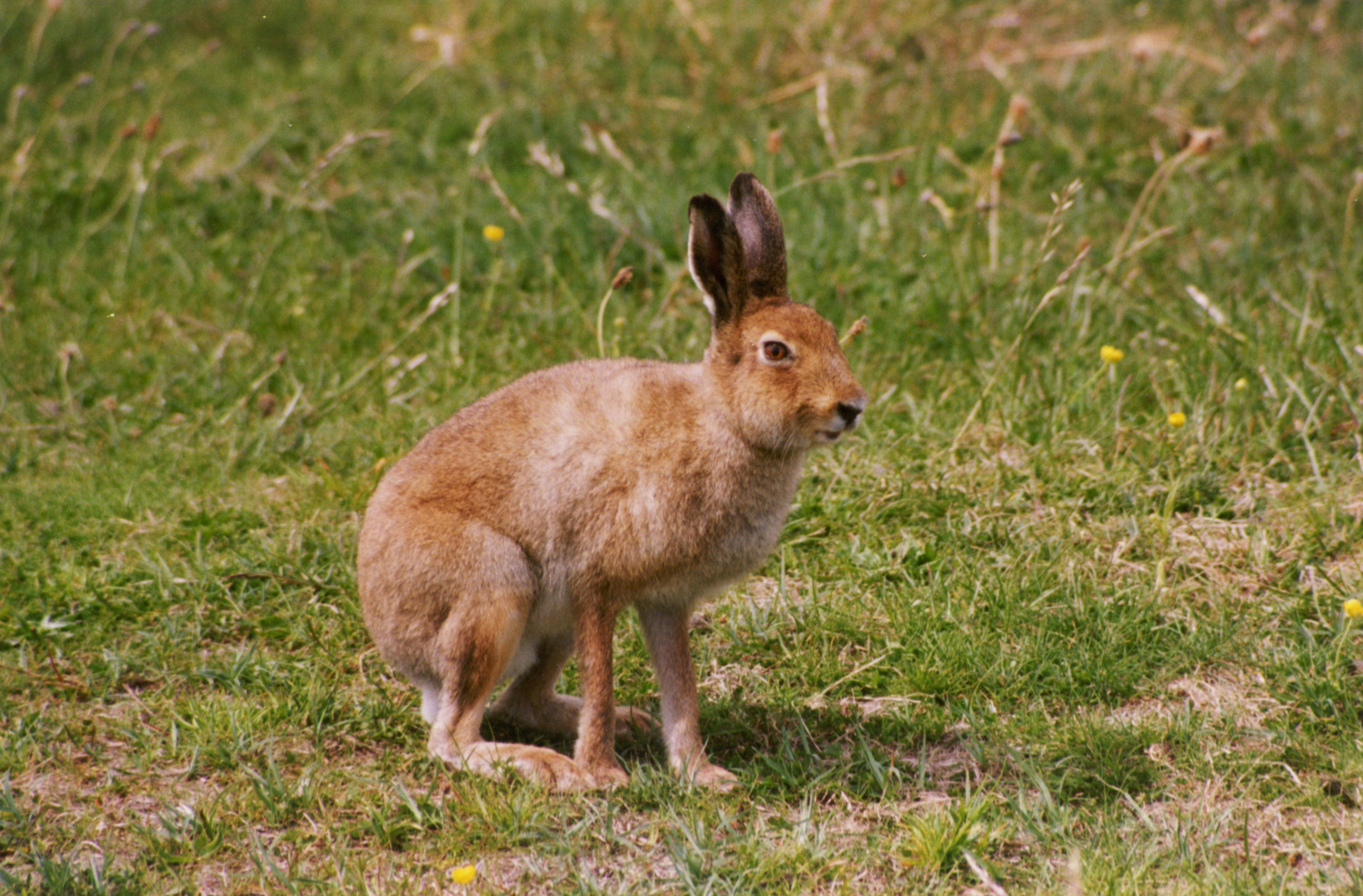 White hare in summer. Photos from Ireland.
White hare in summer. Photos from Ireland. 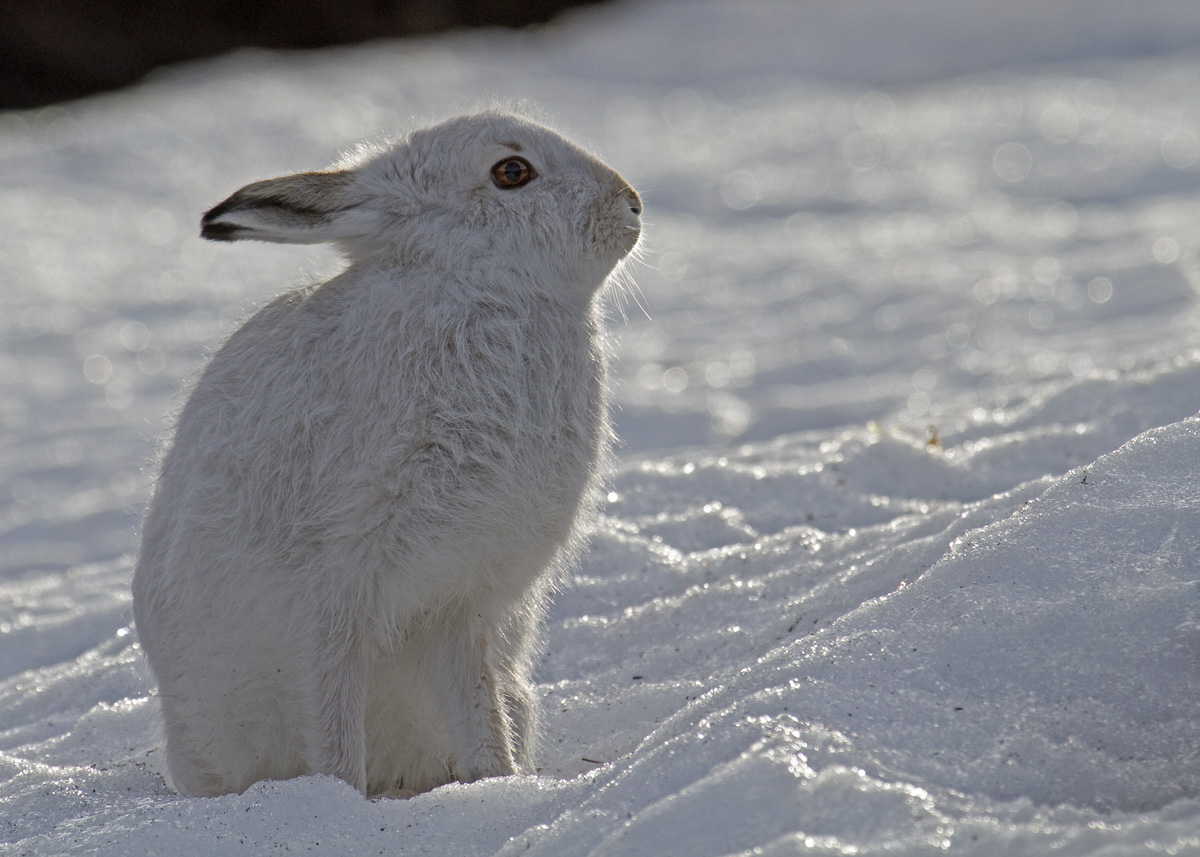 White hare in winter.
White hare in winter. White hare eating
Hares are herbivorous animals. Starting in spring, when the first greens appear, and throughout the summer they feed on succulent herbs. The number of plant species used for this is quite large, since, on the one hand, hares are settled on a very extensive territory, and, on the other hand, they are “omnivorous” in relation to plants. However, in any part of the range, they prefer legumes and cereals, dandelion and yarrow, clover and sedges. In the north-west, where there is a lot of blueberries, they willingly eat its shoots and fruits. White hare from horsetails and headless mushrooms (deer truffle), which can be easily dug out of the ground, and even wormwood eat, do not refuse. In the summer, hares drink quite often water. In the autumn, the hare trees switch to rough food: small branches, shoots, bark of shrubs and trees. Everywhere prefer willow and aspen. However, depending on the habitat, they eat the bark from birch and larch trees, they eat oak, maple and hazel sprouts. If possible, eat the fruits of mountain ash, bird cherry and alder, as well as juniper and rosehip. Hay in a stack can also be a good help in the winter ration of hares. Herbivorous animals usually lack mineral salts. In order to compensate for this deficiency, the whites periodically swallow small pebbles and soil particles, willingly go to salt licks, gnaw the bones of animals and thrown elk horns.
Breeding hare
The hares are quite prolific and with the onset of spring they begin to multiply. In the northernmost habitat areas, offspring are born only once a year, in the greater territory this happens 2 times a year, and in the southern parts of the range - 3 times. During the rut, females attract males with a characteristic cry. White stalker runs violently, and fights often occur between males that group the same female in pursuit of the same female. Pregnancy lasts 47 - 55 days. The first rabbits appear in April - May. Shortly after the lambing, the second rut passes, and in June-July, the second litter rabbits appear. After the third rut, the hares are born in August-September, when the leaves are already falling, therefore they are called leaf-fallers. Sometimes the first rabbits appear in March, and the last in November, but they all usually die. The number of hares in a litter varies from 1 to 11 and depends on the habitat of the animals, as well as on the age and condition of the female. In the northern parts of the range, on average, 7 hares are born, and in the middle and southern ones, 2-5 hare are born in the litter. As a result, the fecundity of white hares is approximately the same throughout the area. More hares are born in the second litter. At the end of pregnancy, the female finds a secluded place in the thick of bushes, where she passes the lambing. Tundra hares sometimes make shallow brood holes. Hares appear sighted with thick wool and weighing 90-130 grams. Soon after birth, they can already move independently, but the whole brood is kept near the mother and does not disperse. Bunny's milk is very nutritious and contains a lot of fat, so she feeds babies once a day, and sometimes less often. After feeding, it leaves and returns only the next day. Often hares feed other people's hares. The young grow quite quickly: after a week they begin to eat grass, and after 2 weeks they are already independent. They become sexually mature at 10 months. Under natural conditions, white hares live 7–9 years, but often die much earlier. From 2 to 7 years old hares are the most prolific, but from 4 years their fertility decreases.
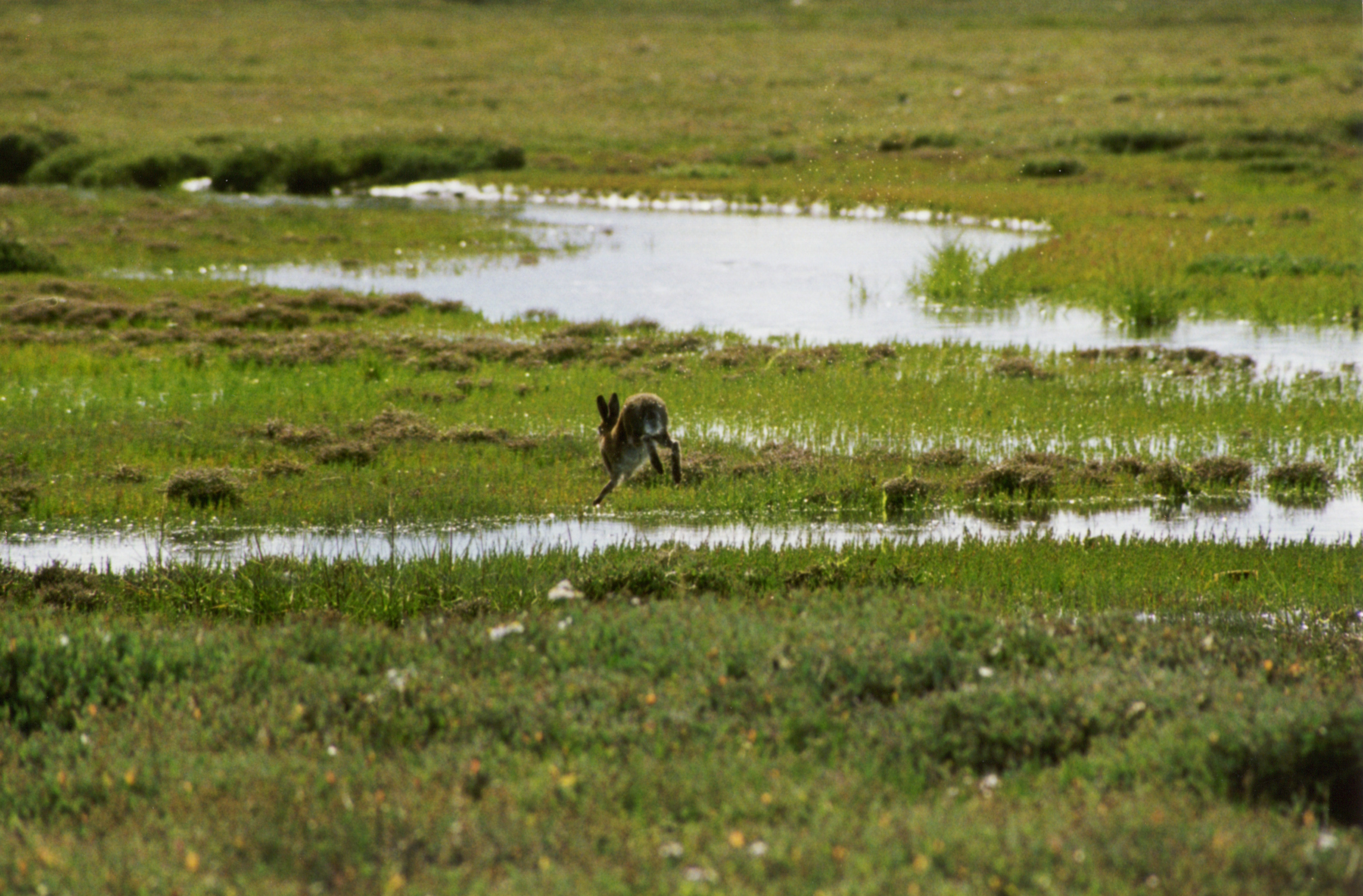 White hare male. Photos from Ireland.
White hare male. Photos from Ireland. 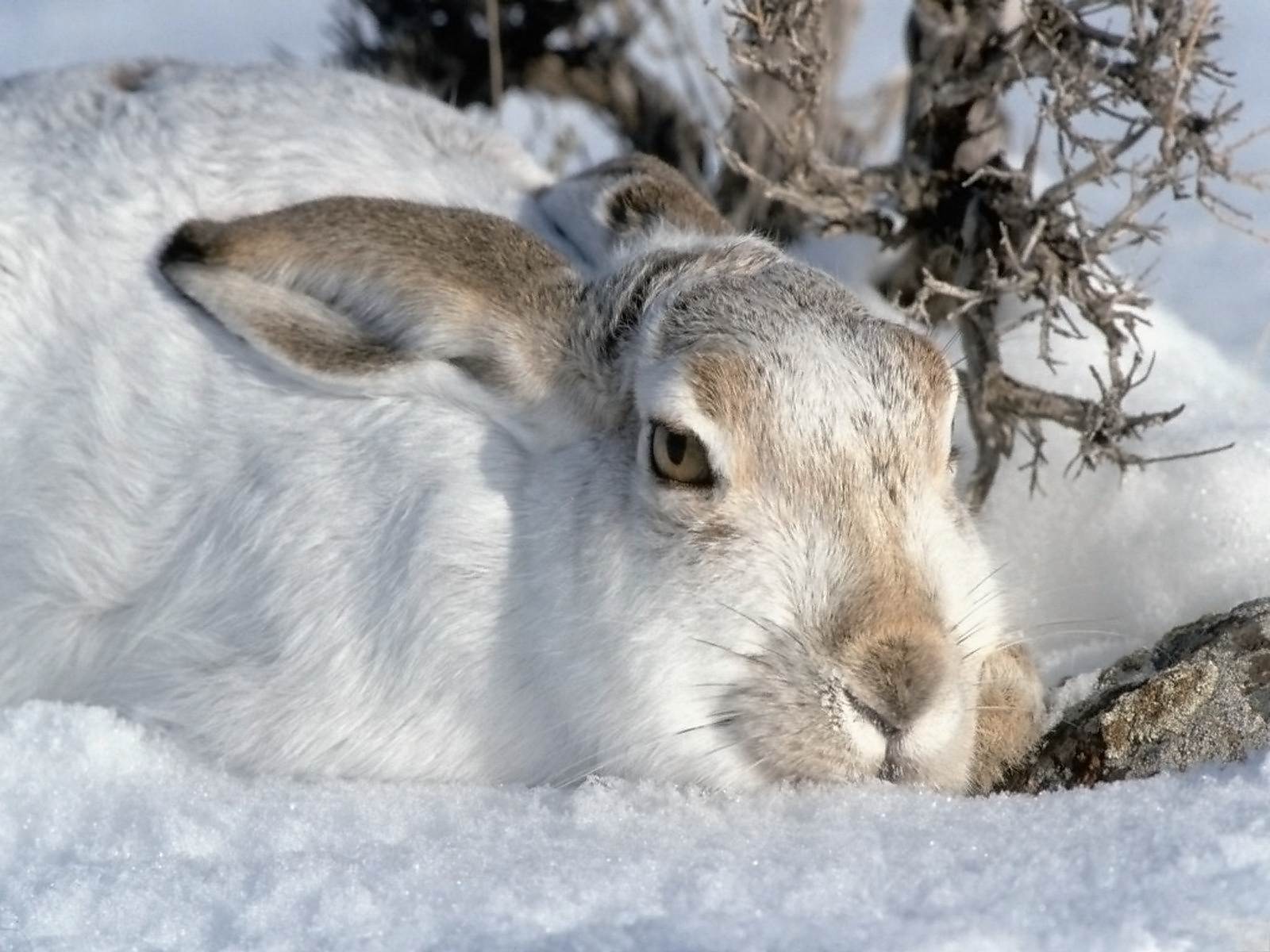 White hare in the snow.
White hare in the snow.  Young hare.
Young hare.  White hare.
White hare. 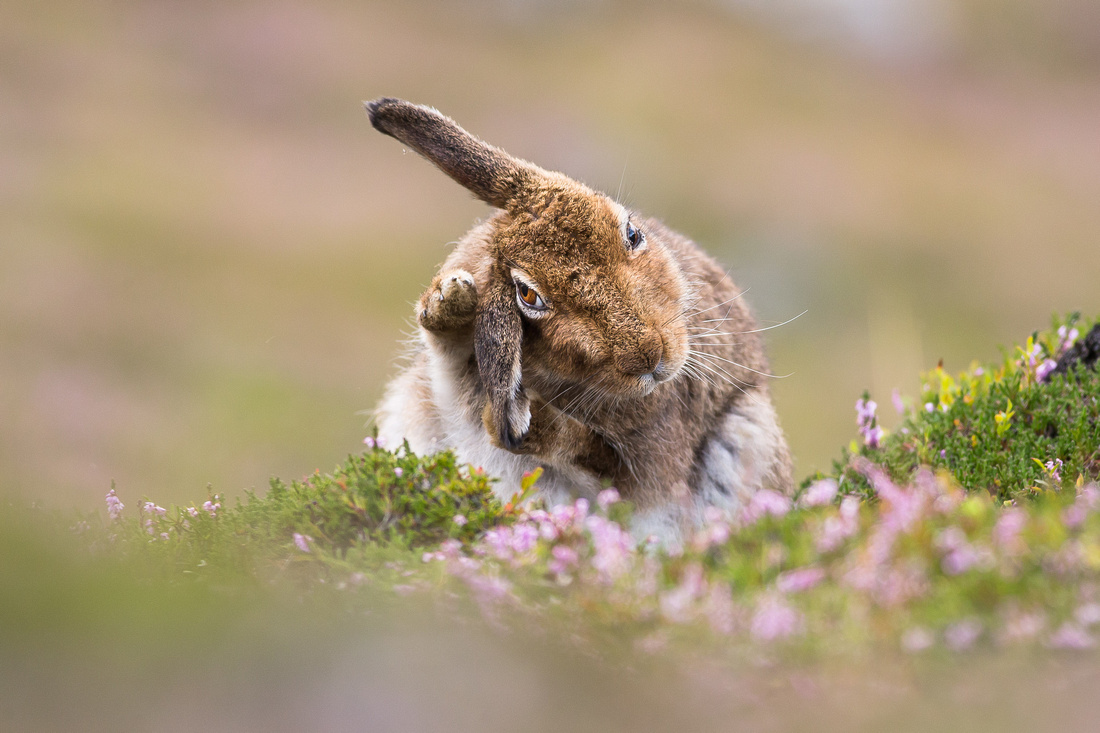 White hare.
White hare. The number of hare and value for humans
The number of hare hares everywhere varies considerably from year to year. On the territory of Russia, very large changes (sometimes hundreds of times) occur in Yakutia. This phenomenon occurs mainly due to epizooty, which occur with a significant increase in the number of hares. As a result of the epizootic, the nature of which is not always established, there is a massive death (sometimes 100% of the local population) of animals. With an increase in the number of hares, the number of predators that destroy them also increases. During the epizootic period, predators contribute to the speedy extinction of hares. The abundance of white hawks and their almost complete disappearance alternates with years with a certain frequency. In the north, it is about once every 10-12 years, and in the south it is somewhat more frequent. However, the entire area at the same time is never covered by a sharp increase in the number or the sea of \u200b\u200banimals. White hare quite easily and quickly adapts to the human neighborhood. At the same time, the "emboldened" white hares can carry significant damage to gardens (especially in winter) and forest belts.
Hunting hare
White hare is everywhere hunted. It has long been mined for meat, as well as for the skins. Most of the white hare is hunted in Yakutia, where in the "fruitful" years, thanks to this trade, the population gets a lot of good meat.
Photo hare
 White hare on the lawn. Photos from Ireland.
White hare on the lawn. Photos from Ireland. 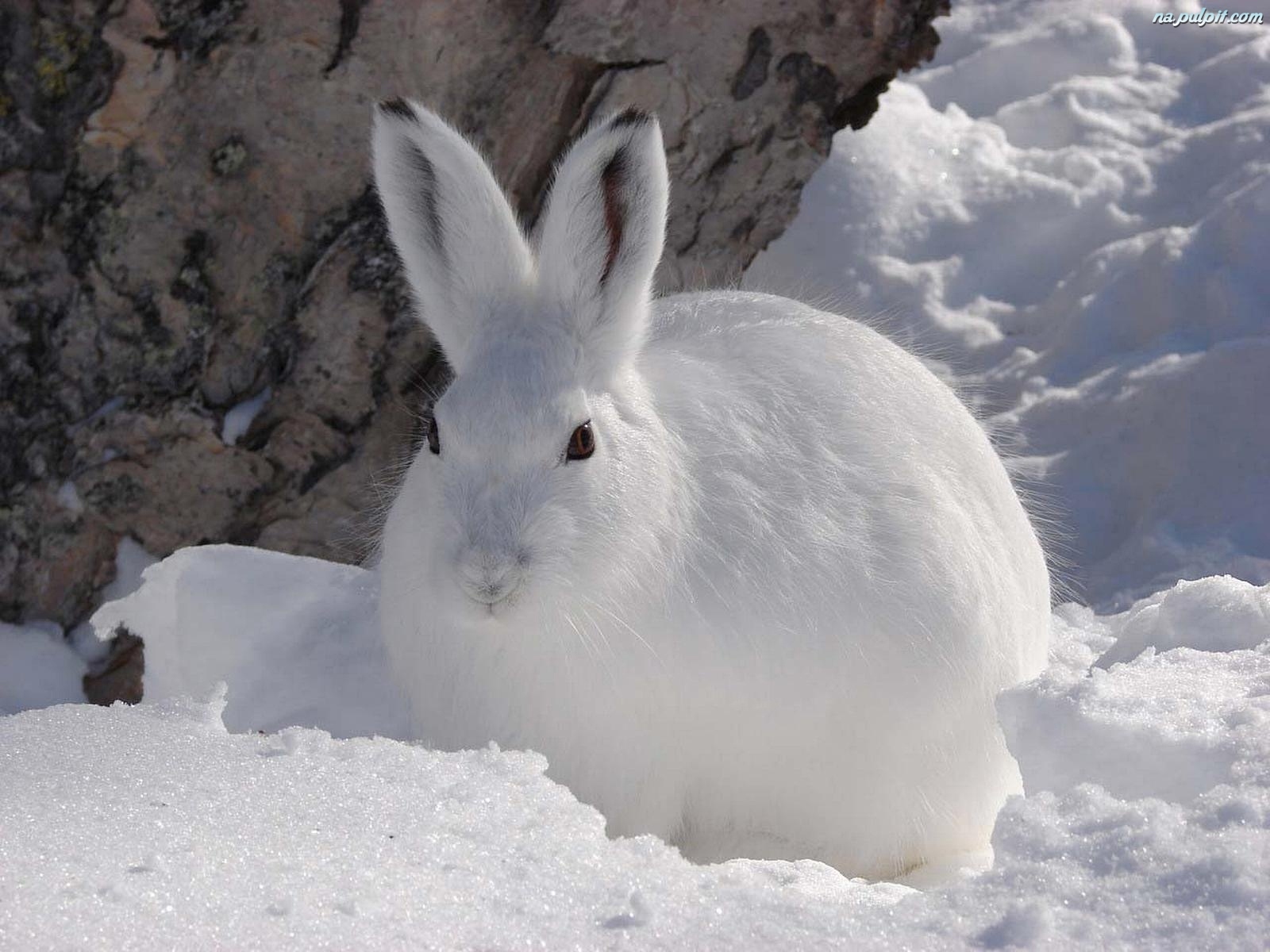 White hare in the snow.
White hare in the snow.
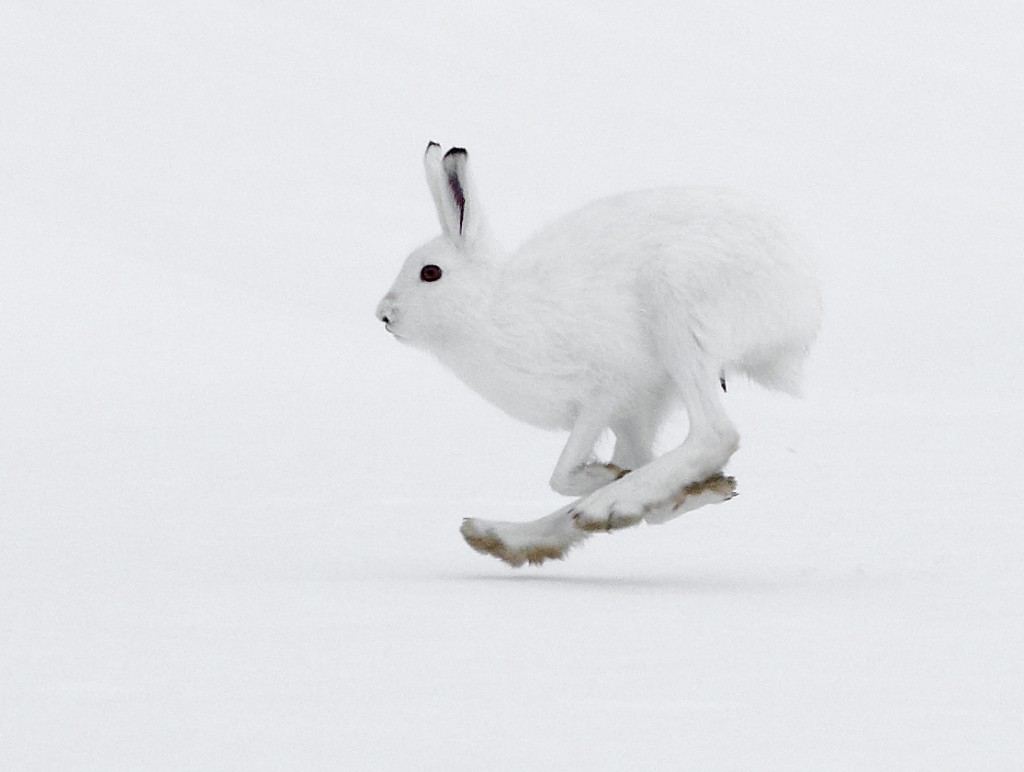 White hare is running.
White hare is running.
For a very long time, zoologists have mistakenly ranked hares to the order of rodents. However, this surprisingly sensitive and fleet-footed creature is descended from other ancestors and is not related to rodents.
HABITAT
The motherland of the hare of the hare is endless Asian steppes, and the favorite habitat is the open areas in the temperate zone. Most willingly, hares live on meadows, grain fields and forest edges, but are also found in weeds overgrown with weeds and in high-grass glades in the middle of the forest. In the mountains, they do not rise above 2000 m above sea level. The ideal habitat of the hare is a place with loose soil, densely overgrown with lush meadow grasses, preferably with rarely scattered clumps of shrubs. Areas of intensive agricultural production with a predominance of monocultures, as well as damp and cold coniferous forests, hares are resolutely avoided.
LIFESTYLE
Self-respecting hare acquires a home site, the boundaries of which marks its smell. To do this, he rubs his chin on low branches of bushes, leaving them with odorous tags, or, crouching on the ground, drops his “calling card” in the form of a drop of anal secretion glands. Most often, the hare peacefully shares its possessions with other hares, but each animal moves only along the paths trodden by its own paws. During the day, he rests, lying motionless under a bush or in a grassy overgrown hollow, trying to completely merge with his surroundings. The hare is lying very “firmly” and takes off almost from under the feet of a close-fitting predator. With the onset of night, the animal goes to feed, and sometimes in search of lush greenery runs many kilometers. Sometimes a whole company of hares gathers on one pasture, but they feed separately, as if not noticing each other. The main dish on this hare's menu is various herbs, especially sweet clover, dandelions, cereals, carrots and wild berries. When there is plenty of food, it goes without watering, getting enough moisture from plant tissues. In winter, the hare switches to woody shoots, branches and seeds of various plants and is readily supported by cabbage left in the gardens, “washing it down” with snow. Hares left over the winter often gnaw the bark of fruit trees, causing significant damage to the gardens, and even have to eat carrion in strong feedless people in order not to die of starvation.
SECURITY
From time immemorial, all large predators - from wolves and foxes to a man with a hunting rifle - consider the hare to be their legitimate prey. Although, at first glance, the hare population is not in danger, their habitat is rapidly declining. The practice of growing monocultures in large areas condemns all the surrounding hares to winter starvation and starvation. Mineral fertilizers and pesticides annually kill up to 15% of hare juveniles, while adults, eating poison with greens, weaken and cannot resist diseases. A lot of hares die under the wheels of cars, combines and other equipment during field work. In an effort to preserve the livestock of these animals, the authorities of many countries have reduced the hunting season for them. Attempts to breed hares in captivity, followed by resettlement in the wild, unfortunately, failed.
Reproduction
Husky breeding season lasts from January to September. During the rut period, males often fight for the right to mate with a female: standing on their hind legs, opponents pound each other's front and scratch their claws. Such clashes often end in deep wounds, stripped ears or tails. Winner immediately starts courting. Early in the morning, the female gives a signal, invitingly drumming her paws on the ground, and the gentleman is already here. Approaching the lady of the heart, the partner sniffs her face, and then, standing on his hind legs, turns the front pedals of an invisible bicycle. The female responds with the same movements. Sometimes other males catch love games, and then enraged rivals will weigh each other strong slaps. As soon as the female expresses readiness, the partners mate and immediately part. After a six-week pregnancy, the female brings 3-5 hares. Cubs will be born in a shallow hollow, right on the bare ground. Immediately after birth, the mother leaves the nest, so as not to pass on to offspring of its smell. The first 2-3 days the kids are kept together, and then everyone finds a shelter in the grass or bushes.
A week later, they begin to tweak weed, but the mother feeds them with milk for up to a month, resorting once a day. After that, she ceases to be interested in her children, and provides them with their own concerns. At 9 months, the young hare can no longer be distinguished from an adult. The female becomes sexually mature at 6 months of age, and the male at the age of 9-12 months.
TERMS
Wits - a large leap hare away from his footprint.
DID YOU KNOW?
- To replenish the supply of vitamins necessary for the body, the hare eats its own feces. This unusual phenomenon is called coprophagy. In the cecum, the hare forms a special soft feces in the form of small, mucus-covered globules, which consist of partially digested and vitamin-rich food. Secondarily digested feces have the appearance of dry pellets.
- The hare is endowed with unusually acute hearing and flair, but his eyesight is weak. The animal’s long ears can move independently of one another and turn outward 190 °. Vibrissae help the animal to navigate in space at night.
- In regions with a temperate climate, the hare hare gives up to four litters a year: at the end of pregnancy, 4 days before giving birth, the female can mate again and then bear the embryos in two uterine horns at once. In one of them are already ripe and ready to be born, and in the other the development of embryos is just beginning. Cubs of the second litter will be born after 5 weeks.
- When walking or jumping, the hare steps on the entire surface of the feet, and when running fast, it relies only on the fingertips.
RELATED SPECIES
The lagup detachment consists of two families: the hares and rabbits belong to one of them, and the spikes to the other. Zoologists distinguish 22 species of hares, which in many inhabit North America, Africa, Europe and Asia. Hares living in Australia and New Zealand, were brought there by humans. All hares are small and medium-sized herbivorous animals, well adapted to life in open spaces. They can be divided into three groups: the inhabitants of the circumpolar, temperate zones, as well as deserts and tropics.
American (small) white- a typical resident of the circumpolar. It lives in the northern regions of North America.
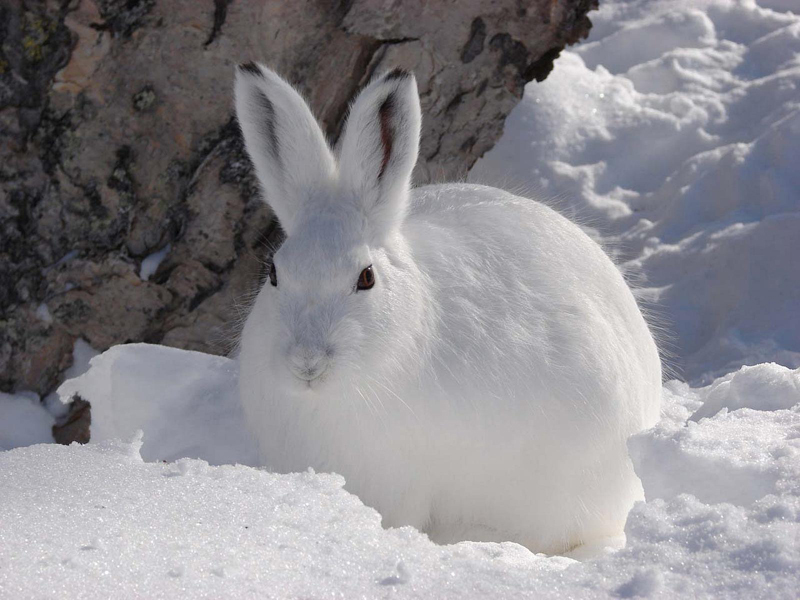
Dark hare - is one of the tropical hares. It is found in India: introduced to the islands of Java and Mauritius.

California hare - representative of hares of a temperate climate zone. It inhabits the western states of the USA.
